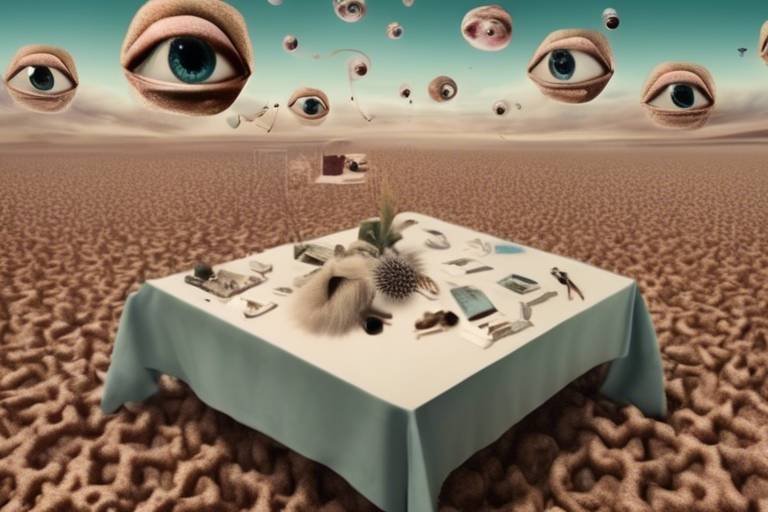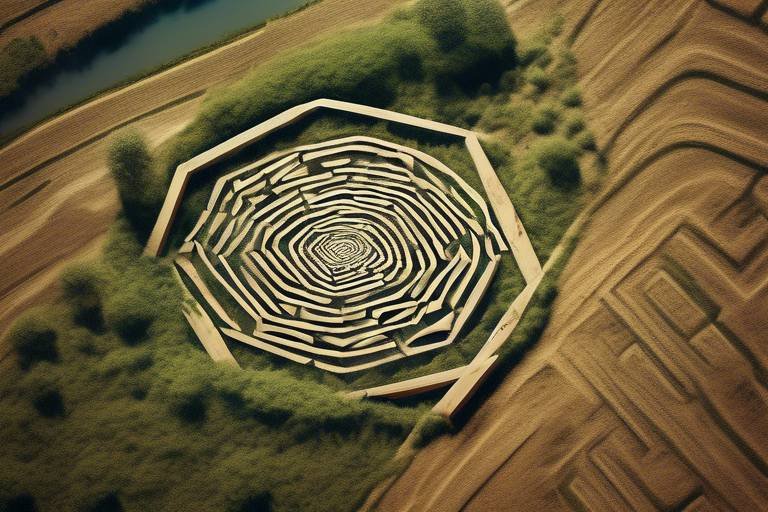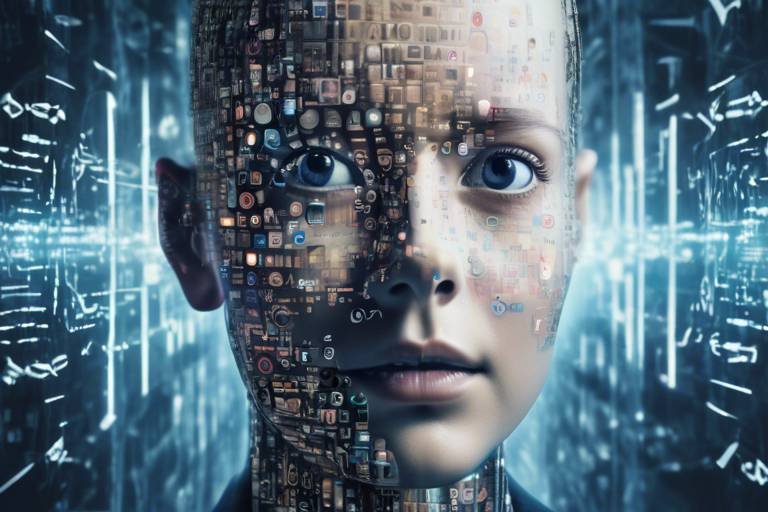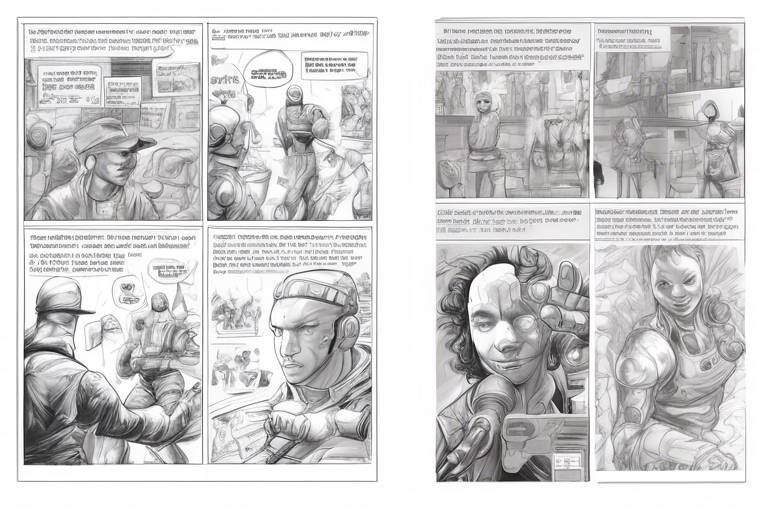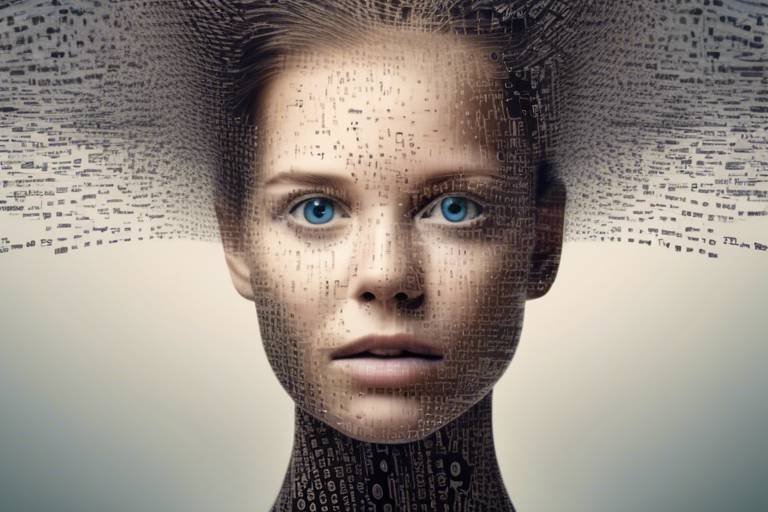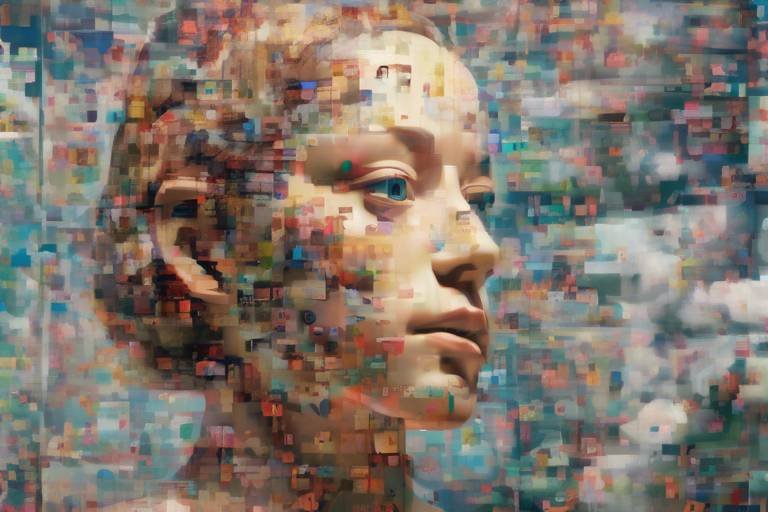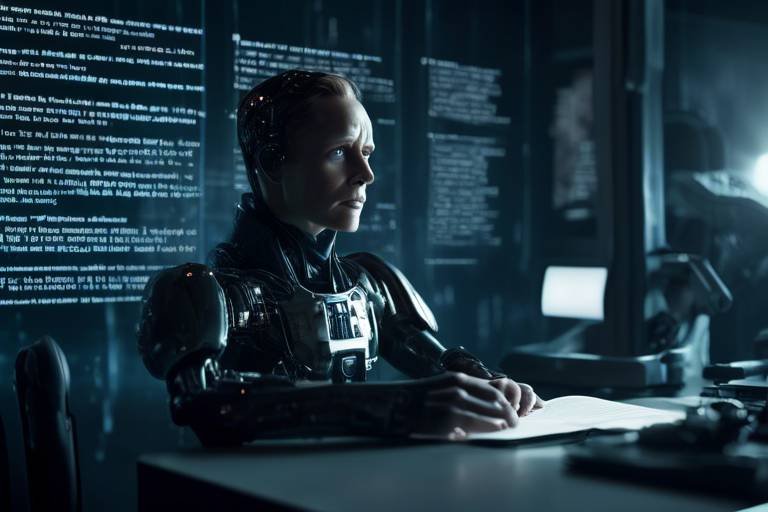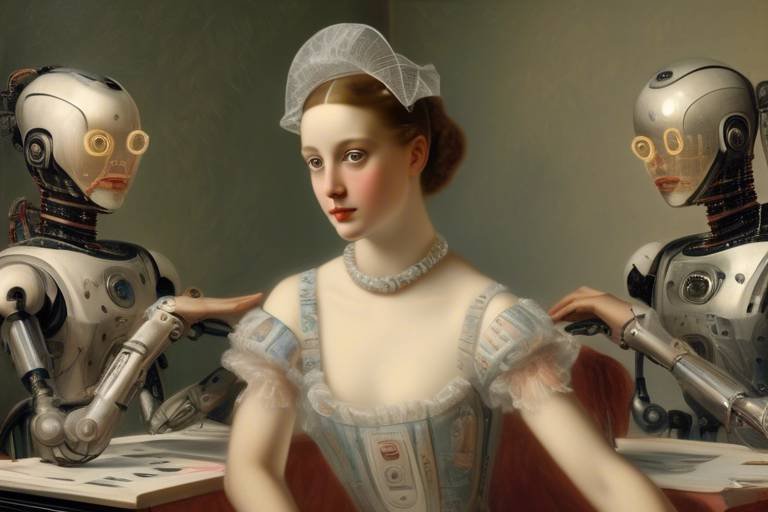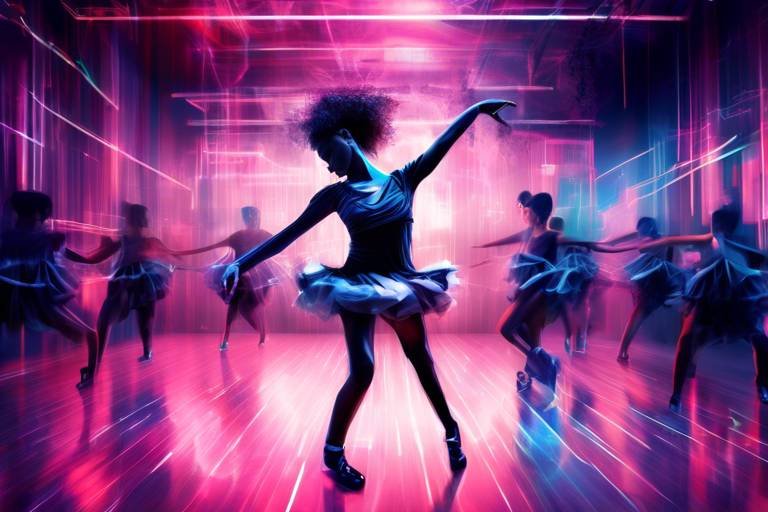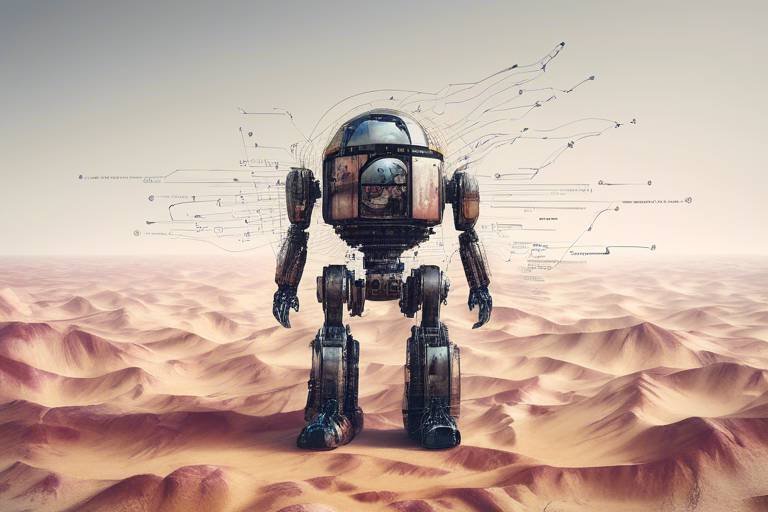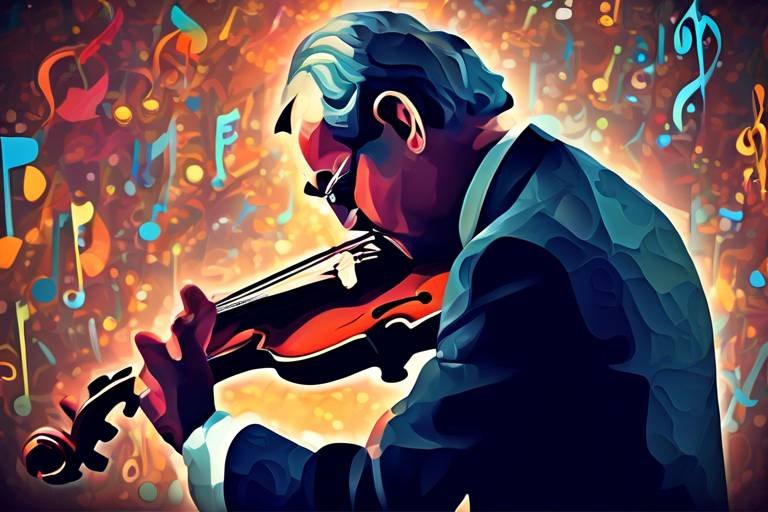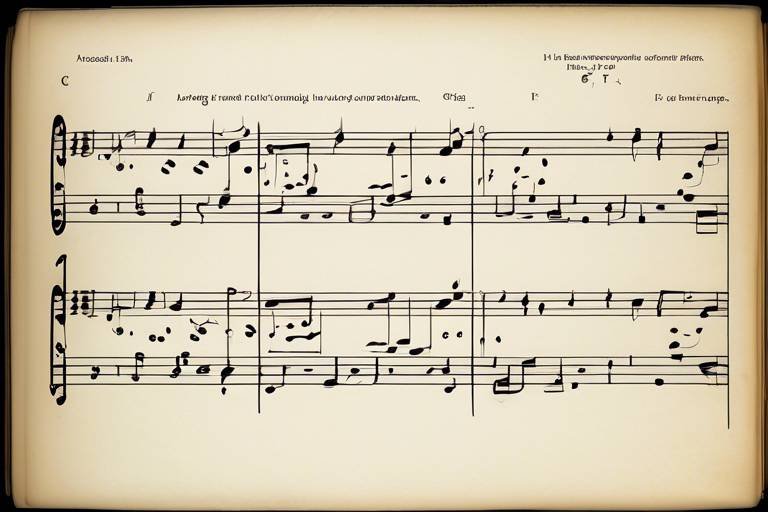Reinventing Surrealism with AI
Welcome to the fascinating world where art and technology collide! The surrealist movement, known for its dreamlike, often bizarre imagery, is undergoing a remarkable transformation thanks to the rise of artificial intelligence (AI). Imagine stepping into a realm where machines not only assist in creating art but also challenge our perceptions of reality. This article explores how AI is reshaping the surrealist art movement, pushing the boundaries of creativity and inviting us to rethink what art can be.
Surrealism has always been about exploring the depths of the human psyche, tapping into dreams, and expressing the irrational. With AI, artists now have a new set of tools that can generate unique and thought-provoking imagery. But how does this work? What does it mean for the future of art? Let’s embark on this journey together as we delve into the intersection of technology and creativity, showcasing innovative works that not only challenge traditional artistic boundaries but also ignite our imagination.
As we navigate through this article, you'll discover the evolution of surrealism, the role of AI as a creative tool, and the exciting collaborations between artists and machines. We'll also discuss the impact of AI-generated art on art communities, the challenges it presents, and the future trends that are on the horizon. So, buckle up as we explore this brave new world of surrealism reinvented by AI!

The Evolution of Surrealism
Surrealism, a movement that emerged in the early 20th century, has undergone a fascinating transformation since its inception. Initially rooted in the aftermath of World War I, it sought to challenge the constraints of rational thought and conventional artistic expression. The early surrealists, like André Breton and Salvador Dalí, drew inspiration from the subconscious, dreams, and the irrational. They believed that by tapping into the depths of the human psyche, they could unlock a new realm of creativity that defied logic and embraced the bizarre.
As time progressed, surrealism began to evolve, adapting to the changing cultural landscape. The 1920s and 1930s saw surrealism flourish, with artists experimenting with various techniques such as automatism and collage to express their visions. This period was marked by a sense of liberation, as artists sought to break free from traditional norms and explore the complexities of the human experience. The movement not only impacted visual arts but also literature, film, and theater, creating a rich tapestry of surrealistic expression.
In the latter half of the 20th century, surrealism began to blend with other artistic movements, such as abstract expressionism and pop art. This fusion resulted in new interpretations and styles, showcasing the adaptability of surrealist principles. Artists like Max Ernst and Rene Magritte pushed the boundaries of surrealism, infusing their works with personal narratives and socio-political commentary, which resonated with audiences on a deeper level.
Today, the evolution of surrealism continues to unfold, with contemporary artists drawing from both historical influences and modern technology. The rise of digital art and artificial intelligence has opened up new avenues for creative exploration. Artists are now able to experiment with AI-generated imagery, merging traditional surrealist themes with cutting-edge technology. This fusion not only challenges our understanding of authorship and creativity but also invites a broader audience to engage with surrealism in innovative ways.
To illustrate the evolution of surrealism, let's take a look at some key figures and their contributions throughout the years:
| Artist | Contribution | Era |
|---|---|---|
| André Breton | Founder of surrealism, introduced the concept of automatism | 1920s |
| Salvador Dalí | Known for dreamlike imagery and technical skill | 1920s-1930s |
| Max Ernst | Pioneered collage and frottage techniques | 1930s |
| Rene Magritte | Challenged perceptions of reality through visual paradoxes | 1930s-1960s |
| Contemporary Artists | Utilizing AI and digital media to reinterpret surrealism | 21st Century |
As we look to the future, it's clear that surrealism will continue to adapt and evolve. The integration of technology into artistic practices not only preserves the essence of surrealism but also expands its reach and relevance in a rapidly changing world. This ongoing evolution invites us to ponder: how will the next generation of artists redefine the surrealist landscape?

AI as a Creative Tool
Artificial intelligence is not just a buzzword in the tech world; it's becoming a revolutionary creative tool for artists across the globe. Imagine a world where machines collaborate with humans to create art that transcends our wildest dreams. Sounds surreal, right? Well, that's the reality we're stepping into. AI technologies are being harnessed to generate surreal imagery that not only enhances artistic expression but also expands the boundaries of creativity itself.
One of the most fascinating aspects of AI in art is its ability to analyze vast amounts of data. By studying existing artworks, AI can identify patterns, styles, and themes that resonate with the principles of surrealism. This capability allows it to create unique pieces that challenge our perception of reality. Think of AI as a modern-day artist's apprentice, tirelessly learning from the masters while pushing the envelope of what art can be.
At the heart of AI-generated art are machine learning algorithms. These algorithms are designed to learn from data inputs, making them invaluable in the art creation process. They analyze everything from brush strokes to color palettes, enabling them to generate artworks that echo the surrealist movement. For instance, an algorithm might take inspiration from Salvador Dalí's melting clocks and create a piece that features time in a completely new, abstract form.
One of the most groundbreaking technologies in this realm is the Generative Adversarial Network (GAN). GANs consist of two neural networks—the generator and the discriminator—that work in tandem to create art. The generator creates images, while the discriminator evaluates them, providing feedback to improve the generator's output. This back-and-forth process leads to the creation of surreal artworks that not only captivate but also provoke thought. Imagine gazing at a piece that seems to warp reality itself, making you question your senses.
Another exciting application of AI in art is through style transfer techniques. This process allows artists to blend different artistic styles seamlessly. For example, an artist can take the dreamlike quality of a classic surrealist painting and merge it with the bold colors of modern abstract art. The result? A stunning composition that pays homage to the past while embracing the future. It's like having a time machine for art, where styles from different eras collide and create something entirely new.
As we delve deeper into the creative potential of AI, we see that the collaboration between human artists and AI systems is becoming increasingly prevalent. This synergy is not just about machines taking over; it's about enhancing human creativity and exploring new avenues of artistic expression. The future is bright for artists willing to embrace this technology, as they can push their creative boundaries further than ever before.
- What is AI-generated art? AI-generated art refers to artwork created with the assistance of artificial intelligence technologies, often utilizing algorithms to produce unique and imaginative pieces.
- Can AI truly be creative? While AI can generate art that appears creative, it does so based on learned patterns and data rather than genuine inspiration or emotion.
- How does AI impact traditional artists? AI serves as a tool for traditional artists, allowing them to explore new techniques and styles, rather than replacing their unique creative voices.
- Are there ethical concerns regarding AI in art? Yes, concerns about authenticity, authorship, and the potential dilution of artistic value are prevalent discussions in the art community.

Machine Learning Algorithms
Machine learning algorithms are like the secret sauce behind the magic of AI-generated surreal art. They analyze a vast array of existing artworks, learning from the styles, colors, and themes that define the surrealist movement. Imagine teaching a child to paint by showing them thousands of paintings; that's essentially what these algorithms do, but at a scale and speed that no human could ever match. They sift through data, identifying patterns and nuances that can inspire new creations. This process not only generates unique pieces but also reflects the core principles of surrealism—dream-like imagery, bizarre juxtapositions, and the exploration of the unconscious mind.
One of the most fascinating aspects of machine learning in art is how these algorithms can create something entirely new while still being rooted in existing works. They can remix styles, blend elements from various artists, and even incorporate unexpected surprises that challenge our perceptions. For instance, an algorithm might take the vibrant colors of a Dali painting and combine them with the abstract forms of a Magritte piece, resulting in a creation that feels both familiar and alien. This ability to synthesize different influences opens up a world of possibilities for artists looking to push the boundaries of their creativity.
To better understand how machine learning algorithms work in the realm of surrealism, let's break down a few key types:
- Supervised Learning: This involves training the algorithm on a labeled dataset, where each piece of art is categorized by style, color, and theme. The algorithm learns to recognize and replicate these characteristics in new creations.
- Unsupervised Learning: Here, the algorithm explores the data without predefined labels, seeking out patterns and relationships on its own. This method can lead to unexpected and innovative results, much like a surrealist artist who follows their intuition.
- Reinforcement Learning: This approach teaches the algorithm through trial and error, rewarding it for producing desirable outcomes. It’s akin to an artist refining their technique over time, learning from both successes and failures.
As machine learning algorithms continue to evolve, the potential for creating surreal art expands exponentially. They can learn from an ever-growing database of artworks, adapting and innovating in ways that challenge traditional artistic boundaries. The result is a dynamic interplay between technology and creativity, where the possibilities for expression are limited only by the imagination of the algorithm and the artists who harness its power.
In conclusion, machine learning algorithms are not just tools; they are collaborators that enable artists to explore the surreal in ways that were previously unimaginable. They invite us to question our understanding of art, creativity, and the very nature of inspiration itself. As we continue to embrace these technologies, the future of surrealism promises to be as unpredictable and fascinating as the art form itself.

Generative Adversarial Networks (GANs)
Generative Adversarial Networks, or GANs, have emerged as a groundbreaking technology in the realm of art creation, particularly within the surrealist movement. Imagine a painter who can continuously learn from every brushstroke, evolving their style with each piece they create. That's essentially what GANs do—they consist of two neural networks, the generator and the discriminator, that work in a competitive manner to produce stunningly imaginative artworks.
The generator's role is to create new images based on the input it receives, while the discriminator evaluates these images against a dataset of existing artworks. Through this back-and-forth, both networks improve over time, resulting in creations that can blur the lines between the real and the surreal. The generator might produce an image of a dreamlike landscape, and the discriminator will either validate it as a convincing piece of art or reject it, pushing the generator to refine its output.
This method not only allows for the production of unique artworks but also challenges our perceptions of authorship and creativity. When a machine can generate an artwork that evokes deep emotions or thought, we must ask ourselves: What does it mean to be an artist in the age of AI? Are these AI-generated pieces merely reflections of human creativity, or do they stand alone as legitimate art forms in their own right?
Some notable examples of GANs in action include:
- DeepArt: This platform uses GANs to transform photographs into artworks that mimic famous styles, creating surreal interpretations of everyday images.
- Artbreeder: A collaborative platform where users can blend images and adjust parameters to generate new artworks, showcasing the power of GANs in creating surreal landscapes and characters.
The implications of GANs extend beyond mere creation; they invite discussions about the nature of art itself. When we consider that these networks can produce pieces that are not only visually striking but also conceptually rich, we find ourselves at a fascinating crossroads of technology and creativity. As artists embrace these tools, we may witness a renaissance of surrealism, where the boundaries of imagination are pushed further than ever before.
In conclusion, GANs are not just a passing trend; they represent a significant shift in how we understand and create art. By harnessing the power of these networks, artists can explore uncharted territories of creativity, making the surreal more accessible and diverse. As we move forward, it's essential to keep questioning the role of AI in art and to celebrate the innovative collaborations that emerge from this exciting intersection.
- What are GANs? GANs are a type of machine learning model that consists of two neural networks—the generator and the discriminator—that work together to produce new data instances that resemble a given dataset.
- How do GANs create art? GANs generate art by learning from a dataset of existing artworks, allowing the generator to create new images while the discriminator evaluates and improves the quality of those images.
- Are AI-generated artworks considered real art? This is a debated topic; while some argue that AI lacks the emotional depth of human artists, others believe that the creativity involved in programming and using GANs qualifies these works as legitimate art.
- What is the future of GANs in art? As technology advances, GANs are expected to become more sophisticated, enabling even greater creativity and collaboration between human artists and machines.

Style Transfer Techniques
Style transfer techniques are an exciting frontier in the realm of artificial intelligence and art. Imagine being able to take the essence of Van Gogh's swirling brushstrokes and apply them to a modern photograph of a bustling cityscape. This is exactly what style transfer enables artists to do—blend different artistic styles to create something entirely new and surreal. At its core, style transfer leverages deep learning algorithms to separate and recombine content and style from two different images, resulting in a unique composition that retains the subject's original context while adopting the aesthetic flair of the chosen style.
The process typically unfolds in several stages. First, an algorithm analyzes the content image, which serves as the base, extracting its structural information. Next, it examines the style image, capturing the unique textures, colors, and patterns that define that particular style. Finally, the algorithm synthesizes these elements, producing a new image that embodies the content of the first and the style of the second. This interplay between content and style creates a visually striking piece that can evoke emotions and provoke thought, much like traditional surrealist works.
One of the most remarkable aspects of style transfer is its ability to democratize art creation. Artists of all backgrounds can experiment with various styles without needing to master each technique individually. This has led to a surge in creativity and innovation, as artists are encouraged to push boundaries and explore new avenues of expression. For instance, an artist might take a classic surrealist painting and apply a contemporary digital art style, creating a dialogue between the past and the present.
Moreover, style transfer techniques have sparked a conversation about originality and authorship in art. With the ability to replicate and transform established styles, questions arise: What does it mean to create art in the age of AI? Can a piece generated through style transfer be considered original, or is it merely a rehash of existing works? These discussions highlight the evolving nature of art in our technologically driven world.
To illustrate the impact of style transfer techniques, consider the following table that showcases some notable applications in the art community:
| Application | Description | Impact on Art |
|---|---|---|
| Instagram Filters | Many social media platforms use style transfer to create artistic filters. | Encourages everyday users to engage with art. |
| Collaborative Projects | Artists collaborate with AI to produce hybrid works. | Blurs the line between human and machine creativity. |
| Exhibitions | Art galleries feature AI-generated pieces using style transfer. | Provokes discussions on the future of art. |
As we continue to explore the intersection of technology and creativity, style transfer techniques will undoubtedly play a crucial role in shaping the future of surrealism. By allowing artists to experiment freely and challenge traditional norms, these techniques not only enhance artistic expression but also invite us to reconsider our understanding of what art can be. So, the next time you encounter a piece that seems to defy reality, remember that behind it may lie the innovative power of AI and style transfer, merging the old with the new in a beautifully surreal way.
- What is style transfer? Style transfer is a technique that allows the merging of the content of one image with the artistic style of another using deep learning algorithms.
- How does style transfer work? It analyzes the structural content of a base image and the aesthetic style of another image, then synthesizes a new image that combines both elements.
- Can anyone use style transfer techniques? Yes! Style transfer democratizes art creation, enabling artists and non-artists alike to experiment with various artistic styles easily.
- What are the implications of AI in art? AI challenges traditional notions of originality and authorship, prompting discussions on the evolving nature of art in the digital age.

Collaborations Between Artists and AI
The collaboration between human artists and artificial intelligence is not just a trend; it's a **revolution** in the art world. Imagine a painter sitting side by side with a machine, where ideas flow seamlessly between human creativity and algorithmic precision. This partnership is reshaping the very fabric of artistic expression, allowing for a **fusion** of imagination that was previously unthinkable. Artists are no longer confined to traditional methods; instead, they are exploring new frontiers where the brush strokes of the past meet the digital strokes of the future.
One of the most fascinating aspects of these collaborations is how they challenge our understanding of **authorship**. When an AI generates a piece of art, who gets the credit? Is it the artist who programmed the AI, or is it the machine itself? This question leads to exciting discussions about creativity and originality. Many artists embrace this ambiguity, viewing AI as a **co-creator** rather than just a tool. For instance, renowned artist Refik Anadol uses AI to create mesmerizing data-driven installations that blend architecture and art. His work showcases how AI can interpret vast datasets and transform them into stunning visual experiences.
Another noteworthy example is the collaboration between artist Mario Klingemann and AI systems. Klingemann specializes in using neural networks to generate surreal and dreamlike images that push the boundaries of perception. His work, which often incorporates elements of glitch art, highlights the potential of AI to produce pieces that are both unsettling and beautiful. This synergy between human intuition and machine learning results in artworks that are not only innovative but also deeply thought-provoking.
These partnerships are not limited to established artists. Emerging creators are also leveraging AI to explore their artistic voices. Many are utilizing user-friendly platforms that allow them to experiment with AI-generated art without needing extensive technical knowledge. This democratization of technology means that anyone with a passion for art can collaborate with AI, opening the door for diverse perspectives and styles.
As we look ahead, the future of these collaborations appears bright. The potential for **innovation** is limitless, with artists continuously discovering new ways to integrate AI into their creative processes. From interactive installations to immersive experiences, the possibilities are as vast as the imagination itself. As technology evolves, so too will the nature of these collaborations, potentially leading to entirely new genres of art that blend human emotion with machine intelligence.
In conclusion, the collaboration between artists and AI is not just about creating art; it's about **redefining** what art can be. It invites us to reconsider our notions of creativity, authorship, and the role of technology in our lives. As we stand on the brink of this new artistic era, one thing is clear: the future of art is a collaborative canvas where humans and machines create together in a dance of creativity that knows no bounds.
- What is AI-generated art? AI-generated art refers to artworks created with the assistance of artificial intelligence, often using algorithms and machine learning techniques.
- Can AI create original art? Yes, AI can create original art by analyzing existing works and generating new pieces based on learned patterns and styles.
- How does collaboration with AI change the role of the artist? Collaboration with AI allows artists to expand their creative processes, offering new tools and perspectives while challenging traditional notions of authorship.
- Are there any ethical concerns with AI in art? Yes, ethical concerns include issues of authenticity, ownership, and the potential for AI to dilute the value of human-created art.
- What are some examples of artists working with AI? Notable artists include Refik Anadol and Mario Klingemann, who use AI to create innovative and thought-provoking artworks.

The Impact on Art Communities
The rise of AI-generated surrealism is creating ripples across art communities globally, shaking the very foundations of how we perceive and appreciate art. Artists, critics, and audiences are grappling with the implications of this technological shift, leading to vibrant discussions and debates. Just think about it: how does one define art when a machine can create something that evokes emotion, thought, and discussion? This question is at the heart of the conversation, as AI continues to blur the lines between human creativity and algorithmic generation.
One of the most significant impacts of AI on art communities is the democratization of the creative process. With tools powered by artificial intelligence, artists—both seasoned professionals and enthusiastic amateurs—now have unprecedented access to resources that enable them to explore new creative avenues. For instance, platforms that utilize AI allow users to generate unique artworks by simply inputting their ideas or preferences. This accessibility means that anyone with a passion for creativity can experiment with surrealism, regardless of their technical skills. It’s like handing a paintbrush to a child and watching them create a masterpiece; the possibilities are endless!
Moreover, AI-generated art is fostering collaboration among artists. Traditional boundaries are dissolving as creators from various disciplines come together to explore the intersection of technology and art. Imagine a painter teaming up with a programmer to create a piece that evolves in real-time based on audience interaction. Such collaborations not only enhance the artistic experience but also challenge the conventional notions of authorship and originality. The synergy between human intuition and machine intelligence is sparking a new wave of creativity that is both exciting and thought-provoking.
However, this evolution is not without its challenges. Many artists and critics express concerns about the authenticity of AI-generated works. Questions arise about who should be credited for the artwork—the artist who conceived the idea or the AI that executed it? This dilemma is reminiscent of the age-old debate in art history about the role of the artist versus the medium. Furthermore, as AI continues to produce art, there is a fear that the value of human-created pieces may diminish. The notion of artistic value is being challenged, and art communities are actively discussing what it means to create and appreciate art in an age of advanced technology.
In response to these challenges, art communities are organizing forums, workshops, and exhibitions to explore the relationship between AI and art. These events serve as platforms for dialogue, allowing artists and audiences to share their perspectives and experiences. They also provide an opportunity for education, helping people understand the technology behind AI art and its implications. Through these discussions, a new understanding is emerging—one that recognizes the potential of AI as a tool for enhancement rather than a replacement for human creativity.
As we look to the future, it’s clear that AI will continue to influence art communities in profound ways. The integration of technology into the creative process is not just a trend; it’s a transformation that is redefining the essence of what art can be. Artists are likely to embrace AI as a collaborator, leading to innovative practices that challenge the status quo. The art world is on the brink of a revolution, and it’s an exhilarating time to be part of it.
- What is AI-generated art? AI-generated art refers to artwork created with the assistance of artificial intelligence, often using algorithms and machine learning to produce unique pieces.
- How does AI impact traditional artists? AI provides traditional artists with new tools for creativity, allowing them to experiment and collaborate in ways that were previously unimaginable.
- Are there ethical concerns regarding AI in art? Yes, there are ongoing debates about authorship, authenticity, and the potential dilution of artistic value in AI-generated works.
- Can AI replace human artists? While AI can generate art, it is unlikely to replace human artists entirely. Instead, it serves as a tool that can enhance and expand artistic expression.

Challenges and Critiques
The rise of AI-generated surrealism has undoubtedly sparked a vibrant conversation within the art community, yet it is not without its share of challenges and critiques. As we embrace this new frontier, questions surrounding authenticity, authorship, and the potential dilution of artistic value have become focal points of debate. For many traditionalists, the introduction of artificial intelligence into the creative process raises eyebrows. Can a machine truly create art? Or is it merely a sophisticated tool that mimics human creativity?
One of the most pressing concerns is the issue of authenticity. In the realm of surrealism, artists often pour their personal experiences and emotions into their work. However, when an AI generates a piece, it lacks the personal touch and lived experience that human artists bring to their art. This raises the question: can we consider AI-generated works as genuine expressions of creativity, or are they simply algorithmic outputs devoid of true artistic intent?
Moreover, the question of authorship looms large. If an AI creates a stunning surreal piece, who is the rightful owner? Is it the programmer who developed the algorithm, the artist who provided the input, or the AI itself? This ambiguity complicates the legal landscape around art ownership and intellectual property, leaving many artists and creators in a quandary.
The potential dilution of artistic value is another critical concern. As AI continues to produce art at an unprecedented scale, some fear that the market may become saturated with works that lack the depth and meaning often associated with traditional art. This could lead to a scenario where the value of unique, hand-crafted pieces diminishes, overshadowed by the mass production of AI-generated art.
Despite these challenges, it's essential to recognize that the conversation around AI in art is still evolving. Many artists are finding ways to integrate AI into their creative processes, using it as a tool rather than a replacement. This partnership can lead to innovative and unexpected outcomes, pushing the boundaries of what we define as art. In fact, some artists argue that AI can enhance creativity by providing new perspectives and ideas that human artists might not have considered.
In conclusion, while the challenges and critiques surrounding AI-generated surrealism are significant, they also serve as a catalyst for deeper discussions about the nature of creativity itself. As we navigate this uncharted territory, it is crucial for artists, critics, and audiences to engage in open dialogue, exploring the implications of technology on artistic expression. Only then can we truly appreciate the potential of AI to transform the surrealist landscape while respecting the rich history and emotional depth that defines the movement.
- What is AI-generated surrealism? AI-generated surrealism refers to artworks created using artificial intelligence technologies that reflect the principles and aesthetics of the surrealist movement.
- Can AI create art that is considered 'real'? This is a subject of debate; while AI can generate visually stunning pieces, many argue that it lacks the personal experience and emotional depth that human artists provide.
- Who owns the rights to AI-generated art? Ownership can be complex; it may depend on the contributions of the programmer, the artist, or the AI itself, leading to legal ambiguities.
- How is AI influencing traditional art forms? AI is being used as a creative tool, allowing artists to explore new styles and techniques, ultimately expanding the boundaries of traditional art forms.

Future Trends in Surrealist Art
The future of surrealist art is not just a blank canvas waiting for brush strokes; it's a vibrant landscape bursting with possibilities, especially as technology continues to evolve at a breakneck pace. Imagine a world where the lines between reality and imagination blur even further, and where artists can tap into the limitless potential of artificial intelligence to create works that challenge our perceptions. As we look ahead, several exciting trends are emerging that promise to reshape the surrealist movement.
One of the most significant trends is the **integration of augmented reality (AR)** into surrealist art. This technology allows artists to overlay digital images onto the physical world, creating immersive experiences that engage viewers in ways previously thought impossible. Picture walking through a gallery where the paintings come to life, morphing and shifting as you move closer. This interaction not only enhances the viewer's experience but also invites them to become part of the artwork itself.
Moreover, **virtual reality (VR)** is poised to take surrealism to new heights. Artists can create entire worlds that viewers can step into, experiencing surreal landscapes and narratives first-hand. This shift from static observation to active participation could redefine how we perceive and interact with art. Imagine donning a VR headset and wandering through a dreamlike environment where gravity doesn't exist, colors defy logic, and the impossible becomes possible. Such experiences could spark deeper emotional connections and provoke thought in ways traditional art forms cannot.
Additionally, the rise of **AI-driven personalization** in art is an intriguing trend. As algorithms become more sophisticated, they can analyze individual preferences and create tailored surreal artworks for each viewer. This level of customization could lead to a new kind of art experience where no two pieces are the same, reflecting the unique tastes and emotions of those who engage with them. It's as if the artwork knows you, speaking directly to your subconscious and evoking personal interpretations.
Furthermore, the collaboration between **artists and AI** is expected to deepen. We can anticipate more partnerships where human creativity merges with machine intelligence, leading to works that are not only visually stunning but also conceptually rich. This synergy could challenge traditional notions of authorship and creativity, prompting discussions about what it means to be an artist in an age where machines can generate art that resonates profoundly with human emotions.
In addition to these technological advancements, we may also see a resurgence of **social commentary** within surrealist art. As global issues such as climate change, political unrest, and social inequality continue to dominate headlines, artists might use surrealism as a tool to reflect and critique these realities. By distorting familiar images and symbols, they can provoke thought and inspire action, making the art not just a visual experience but a powerful commentary on the human condition.
As we venture further into this uncharted territory, it's clear that the future of surrealist art will be a fusion of the real and the imagined, the human and the machine. The possibilities are as vast as the imagination itself, and as artists embrace these new tools and trends, we can expect to witness a renaissance of creativity that challenges our understanding of art and reality. So, are you ready to step into this surreal future?
- What role does AI play in creating surrealist art? AI acts as a creative tool that helps artists generate unique and imaginative pieces by analyzing existing artworks and applying various algorithms.
- How can augmented reality enhance the experience of surrealist art? Augmented reality allows artists to overlay digital elements onto physical artworks, creating immersive experiences that engage viewers on a deeper level.
- Will AI replace human artists in the creation of surrealist art? While AI can assist in generating art, it is unlikely to replace human creativity. The collaboration between artists and AI can lead to innovative and thought-provoking works.
- What are some upcoming trends in surrealist art? Upcoming trends include the integration of augmented and virtual reality, AI-driven personalization, and a focus on social commentary within surrealist themes.
Frequently Asked Questions
- What is the role of AI in surrealism?
AI has become a groundbreaking tool in the surrealist art movement, allowing artists to explore new realms of creativity. By utilizing machine learning algorithms and generative networks, artists can produce unique works that challenge traditional boundaries and offer fresh interpretations of surrealism.
- How do machine learning algorithms contribute to surreal art?
Machine learning algorithms analyze vast amounts of existing artworks to identify patterns and styles. This enables them to create original pieces that embody surrealist principles, resulting in imaginative and unexpected art that pushes the limits of human creativity.
- What are Generative Adversarial Networks (GANs)?
GANs are a type of AI that consists of two neural networks competing against each other: a generator that creates images and a discriminator that evaluates them. This process leads to the production of highly original surreal artworks, transforming how we perceive and interact with art.
- Can AI-generated art be considered authentic?
The authenticity of AI-generated art is a hot topic of debate. Some argue that since AI lacks human emotion and intent, its creations cannot be deemed authentic. Others believe that the collaboration between artists and AI can produce genuine artistic expressions, blurring the lines of authorship.
- What challenges do artists face when using AI?
Artists may encounter several challenges when integrating AI into their work, including concerns about originality, the potential loss of artistic value, and the fear of being overshadowed by technology. Additionally, navigating the ethical implications of AI in art can be quite complex.
- How is the art community responding to AI-generated surrealism?
The art community is experiencing a mix of excitement and skepticism regarding AI-generated surrealism. While some embrace the innovation and the new opportunities it brings, others critique its impact on traditional art forms and question the future of artistic expression.
- What future trends can we expect in surrealist art?
As technology progresses, we can anticipate even more innovative applications of AI in surrealist art. Future trends may include enhanced collaboration between artists and AI, new forms of interactive art, and the continued exploration of the boundaries between human creativity and machine-generated works.

